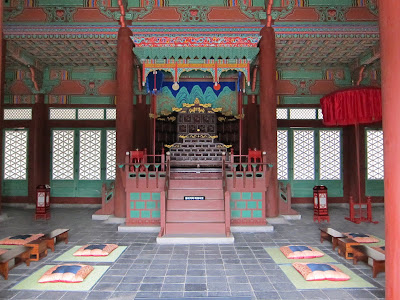To commemorate Seoul's 600 years as the capital of Korea, a time capsule was burried with six hundred items representing what life was in 1994. It is set to be opened for the 1000th birthday of the capital in 2314! This anecdote conveys the struggle in Seoul between modernity and past.
Seoul Time Capsule with the 600 items and artifacts related to the city and
the citizens of 1994, enshrined in the form of miniatures, micro film video-CD
the citizens of 1994, enshrined in the form of miniatures, micro film video-CD
On the side of past and traditions, Koreans took good care and rebuilt many of their royal palaces. Changdeokgung Palace is the biggest one thanks to its phenomenal secret garden which is more like a forest punctuated by wooden pavilions. But well, the different palaces look a lot alike.
Changdeokgung Palace secret garden
Gyeongbokgung Palace main audience hall tower
Gyeongbokgung Palace
Gyeonghuigung Palace Throne Hall
Namsangol Hanok village is another example of Korean respect for their roots. In 1998 were settled five old Hanok houses in a new park in order to gain a glimpse into the lives of Korean ancestors. In one of the houses medical services of traditional korean medecine are offered. We volunteered for a medical examination with differential diagnosis of constitution and consultation and were prescribe Dae-Jang Gum medicinal tea good for constitution enhancing! It was funny and little strange to stick out our tongues to a korean lady doctor in a traditional costume who was looking at them really carefully and seriously.
Traditional Hanok house
Receiving the consult feedback
In the village we also saw an acrobatic Taekwondo show:
******
But in reality, Seoul is one of the most modern metropolis of the world with scyscrapers, a busy traffic and some gardens. Everything and everybody looks so clean and perfectly managed.
Sticker on the metro door
Hongik University metro station
We were very surprised to find a cute little river in the middle of such a huge and crowded city! So we imitate a group of old ladies and dove our feet into the crystal clear waters of Han River.
******
Maybe our days in Seoul were special because we meet our friend Yoon who is a native of this city. She showed us a traditional restaurant where we had a great lunch together, finally knowing what we were eating! :))
And another kind of restaurants where you can choose the seafood you want to eat in an aquarium:


















































